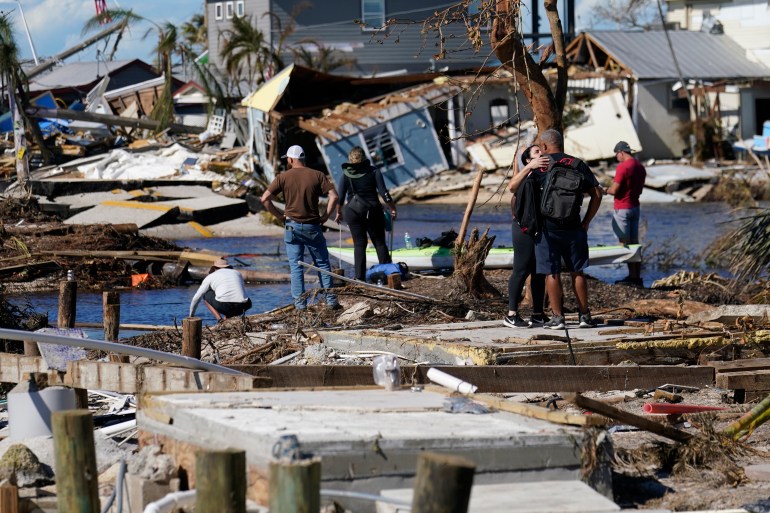Hurricane Ian deals blow to Florida’s shaky insurance sector
About 12 percent of Florida residents have no homeowners’ insurance – rates in the state are far higher than in the rest of the US.

Many residents of Florida whose homes were destroyed by Hurricane Ian are now facing the arduous task of rebuilding without insurance – or paying even steeper prices in an insurance market that was already struggling.
Wind and storm-surge losses from the hurricane could reach between $28bn and $47bn, making it Florida’s costliest storm since Hurricane Andrew made landfall in 1992, according to the property analytics firm CoreLogic.
Keep reading
list of 3 itemsBiden announces new aid for Puerto Rico after Hurricane Fiona
After hurricanes, when to rebuild and when to retreat
Hurricane Ian, which made landfall in Florida last week, has resulted in at least 84 confirmed deaths, including 75 in Florida. Ian’s powerful winds and punishing storm surge knocked out power lines, flooded homes and destroyed businesses.
US President Joe Biden is scheduled to visit Florida on Wednesday to survey the damage by helicopter, receive a briefing on the ongoing response and recovery efforts, and meet with residents and small business owners who have been impacted by the storm, the White House said.
In a fact sheet, the White House said that Biden has issued a declaration that would provide assistance to 17 counties for the removal of debris, as well as other measures.
The White House also said that a $5.2bn bipartisan bill has been approved that would fund more than 100 projects to repair roads and bridges in Florida as well as improve public transportation and replace lead pipes.
Meanwhile, Florida’s home insurance market, even before Ian, was dealing with billions of dollars in losses from a string of natural disasters, rampant litigation and increasing fraud. The difficult environment has put many insurers out of business and caused others to raise their prices or tighten their restrictions, making it harder for Floridians to obtain insurance.
Those who do manage to insure their homes are seeing costs increase exponentially. Even before Hurricane Ian, the annual cost of an average Florida homeowner’s insurance policy was expected to reach $4,231 in 2022, nearly three times the US average of $1,544.
“They are paying more for less coverage,” said Florida’s Insurance Consumer Advocate Tasha Carter. “It puts consumers in dire circumstances.”
The costs have gotten so high that some homeowners have forgone coverage altogether. About 12 percent of Florida homeowners do not have property insurance — or more than double the US average of 5 percent — according to the Insurance Information Institute, a research organisation funded by the insurance industry.
Florida’s insurance industry has seen two straight years of net underwriting losses exceeding $1bn each year. A string of property insurers, including six so far this year, have become insolvent, while others are leaving the state.
As of July, 27 Florida insurers were on a state watchlist for their precarious financial situation. Mark Friedlander, the head of communications for the Insurance Information Institute, expects Hurricane Ian will cause at least some of those to tip into insolvency.
The insurance industry says overzealous litigation is partly to blame. Loopholes in Florida law, including fee multipliers that allow attorneys to collect higher fees for property insurance cases, have made Florida an excessively litigious state, Friedlander said.
Florida currently averages about 100,000 lawsuits over homeowners’ insurance claims per year, he said. That compares to just 3,600 in California, which has almost double Florida’s population.
The Florida Office of Insurance Regulation said the state accounts for 76 percent of the nation’s homeowners’ insurance claims lawsuits, but just 9 percent of all homeowners’ insurance claims.
“Plaintiff attorneys in Florida have historically found ways of circumventing any efforts at reining in legal system abuses, making it likely that ongoing reforms will be needed to further stabilise the insurance marketplace,” said Logan McFaddin of the American Property Casualty Insurance Association.
But Amy Boggs, the property section chair for the Florida Justice Association — a group that represents attorneys — said the insurance industry is also at fault for refusing to pay out claims. Boggs said homeowners are driven to attorneys “as a last resort”.

“No policyholder wants to be embroiled in years of litigation just to get their homes rebuilt,” she said. “They come to attorneys when their insurance company underpays their claim and they can’t rebuild.”
Rampant fraud — particularly among roofing contractors — has also added to costs. Regulators say it is common for contractors to go door-to-door offering to cover homeowners’ insurance deductibles in exchange for submitting a full roof replacement claim to their property insurance company, claiming damage from storms.
Things have gotten so bad with insurance that Florida Governor Ron DeSantis called a special session in May to address the issues. New laws limit the rates attorneys can charge for some property insurance claims and require insurers to insure homes with older roofs — something they had stopped doing because of rising fraud claims.
The legislation also includes a $150m fund that will offer grants to homeowners to make improvements to protect against hurricanes. But that programme has yet to be launched, and experts say it will take years to reverse the damage to Florida’s insurance market.